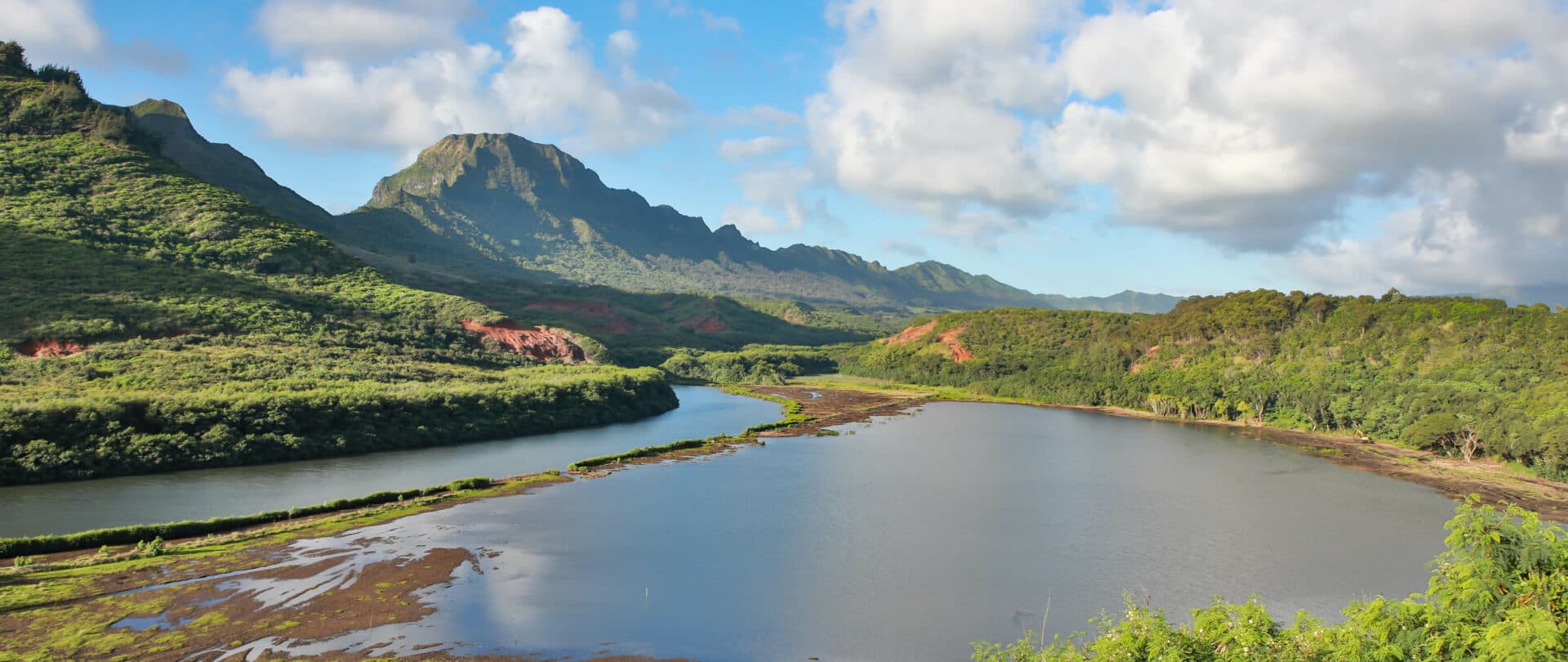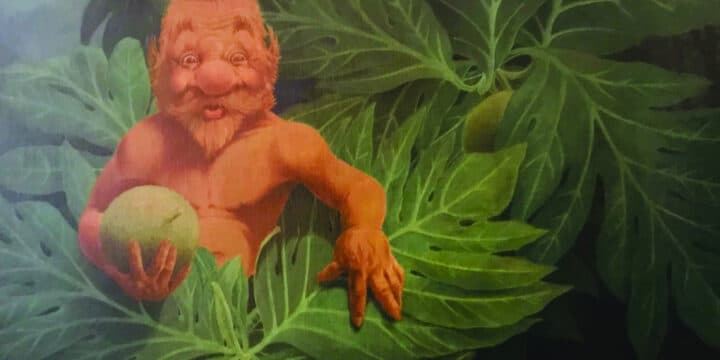
‘Alekoko
A community's preservation effort to restore Menehune Fishpond.
BY Mary Troy Johnston
Menehune...real or mythical? Did they dwell in the forest where they kept their elusive existence even before the arrival of the Polynesians? Under a veil of secrecy, did they build in one night the Menehune Fishpond (traditionally named, Alakoko) on Kaua‘i? Director of the Kaua‘i Museum Chucky Boy Chock recounts tales of the Menehune as he was growing up. He relates his early memories, “As a child around the campfire, Menehune stories were always at the forefront that always captured the imagination of everyone as our grandpa told it. We all believed that the Menehune were small elves like leprechauns that were shy and worked only at night. I believe grandpa shared these stories to keep us close by and not wander into the forest alone; it worked!”
Jan TenBruggencate, author of Menehune Mystery: The Original Tales and the Origins of the Myth, offered his interpretation about the Menehunes’ involvement in building the fishpond. In describing the diversity of stories attached to historic sites (remember, Kaua‘i is the land of talk[ing] story), he thought it possible the historical and magical were fused. He pointed to the Tahitian word, manahune, meaning a person of low social status, and the similarity to the mythical Menehune (socially low people were considered undersized). Therefore, they may have been manual laborers who carried out major construction feats. Jan said one old story is that a chief ordered the construction of the fishpond. Then, after trying to stretch a wall across a wide bend of the river that needed to be about half a mile long found the task too difficult to complete. At that point, the story goes, the Menehune finished the job; and they did their “magic” by contributing to superior construction. In that way, according to Jan, the story of the Menehune as “skilled builders” might have “interacted with the story of magical beings and the robust traditions of the Menehune who did amazing things.”
Martha Beckwith, in Hawaiian Mythology, says the god associated with the “abundance of the sea,” named Ku‘ula-kai was the legendary builder of the first fishpond in Hawai‘i located on East Maui. The association of fishponds with the supernatural is deep in the ancestral memory of Hawaiians. The community had deep ties to fishponds as a source of food as one might have a bond to a piece of agricultural land that has always been in the family. The ponds have been likened to natural refrigerators, not in their cooling properties but in storehouse elements where optimal conditions meant that fish, mainly ‘ama‘ama (striped mullet) and awa (giant milkfish), thrived and grew and were a constant supply.
Restoration of fishponds has been a serious focus in recent years in Hawai‘i for a variety of reasons. With overfishing and loss of seafood species due to other causes, aquaculture (raising fish and seafood in a controlled environment) has become increasingly important as a food source. The Global Seafood Alliance estimates that “by 2030, 62 percent of all seafood produced for human consumption will come from aquaculture.” Fishponds going back some 600 years throughout Hawai‘i represent a peak technology in aquaculture that has become more than evident. The feeling that the knowledge needs to be recovered has taken on urgency with the pace of environmental degradation of water sources.

County Council member Mason Chock speaks to another more culturally significant reason for bringing fishponds back to their former glory. For Kānaka Maoli (Native Hawaiians), ancient sites such as the fishpond hold a “sense of connectivity to ancestors,” a “reconnecting to the source.” He describes ‘Alekoko loko i‘a (the traditional name for the Menehune Fishpond—loko i‘a meaning “fishpond”) as a “historic place and valuable resource to native Hawaiians.” Community attachment to this place continues unabated to this day. Both Mason and Jan describe in diverse ways what this wahi pana (celebrated place) evokes in them. Jan describes being down at the pond and “thinking about the history with tears in his eyes.” He does not know whether to attribute the numinous experience to “history” or something more “ethereal.” Mason considers the “synchronicity and divine guidance” surrounding the community’s efforts in reclaiming this beloved resource.
Mason tells the story of how efforts began to build over a period of a decade to take care of and eventually secure the future of this resource for the community. Members of the Kaiola Canoe Club decided to begin to clear red mangroves on their own because the invasive species was choking the river. Mason described how five boats were able to paddle down the river and turn around in the past, but as the mangrove took over, navigable space became limited to two boats. The canoe club set up a demonstration site to clear mangroves by hand and realized over time they could successfully do so. They then approached residents who lived along the banks of the river and enlisted them in the mission. Red mangroves, which experience enormous growth on Kaua‘i, had done significant damage to Alekoko. Jan describes “how mangroves form a dense community of roots, branches, and trunks” with the effect that sediment does not flush out while the dropped leaves also add to the sediment accumulation. The primary focus was to remove the mangroves. Mason says that the owners of the fishpond in O‘ahu agreed to a twenty-year lease for that purpose. Grants from the Hawai‘i Community Foundation and others supported the efforts with the purpose stated by Mason “for the community to engage and recommit to Hulē‘ia as a wahi pana (‘celebrated place’).” Community involvement took off with organized workdays. Mason describes how he was “initially brought on as a community outreach coordinator and began bringing groups” to the Puali demonstration site. Eventually, volunteers contributed thousands of hours. It was always the belief of the organizers, according to Mason, that “the sustainability of any work we completed would only be sustained by the community’s commitment to its future.” Supported by a variety of funding sources, the clearance area expanded.
In 2015, Mālama Hulē‘ia stepped out from under the canoe club and was established as an independent non-profit to spearhead a larger vision and secure funding. Mālama Hulē‘ia now had a more ambitious program than just to clear mangroves from the Hulē‘ia estuary and river. Remarkable changes had taken place with the removal of the invasive species. Mason describes how native animals began to return. Upon seeing a natural restoration of the traditional environment, interest spawned to restore the area with native plants. Mālama Hulē‘ia defined a larger vision in its bylaws, “to establish a stewardship program and organization that will sustain the restored Hulē‘ia watershed in ways consistent with traditional Hawaiian beliefs and practices in caring for and cultivating land and water.” Mason says it became clear that more was needed than just a 20-year lease to achieve their goals. As president of the board of Mālama Hulē‘ia, along with other members, especially Sara Bowen and Mark Hubbard, Mason began to seek funding to purchase the property if the owners, the Okadas, decided to sell. By now, the story is legend how remarkably the funding came together to enable Mālama Hulē‘ia to purchase the fishpond in 2021. Many donors offered to help, including the county’s open space preservation commission. Eventually, the Trust for Public Land, in partnership with Mālama Hulē‘ia, negotiated a conservation purchase and bought the land with a no-strings-attached donation from Priscilla Chan and Mark Zuckerberg through the Chan Zuckerberg Kaua‘i Community Fund of the Hawai‘i Community Foundation.
Jan, who succeeded Mason as president of the board of Mālama Hulē‘ia, says the vision for the future will depend on the interests the community expresses. The extent to which restoration will continue in terms of repairing the wall, removing sedimentation from hillside run-off due to erosion and mangrove residue, and returning the pond to a fully functional state remain to be decided. However, Jan describes the already established significance of the fishpond “as it provides a wonderful teaching tool” on the immense range of issues related to Hawaiian culture, climate change, science, and nature.
For Mason, the Alekoko restoration is a dream coming full circle. He remembers as a child, he went with his mother to work at the Kaua‘i Surf (currently the Royal Sonesta) at Nawiliwili Bay. Often, they would have breakfast at a lookout with a view of Alekoko. She foresaw and told him, “You are going to have to restore it.”





